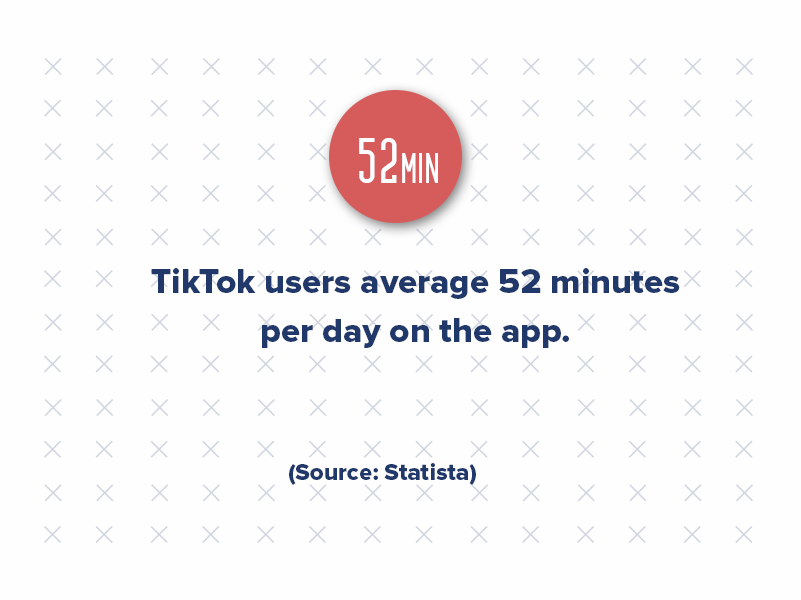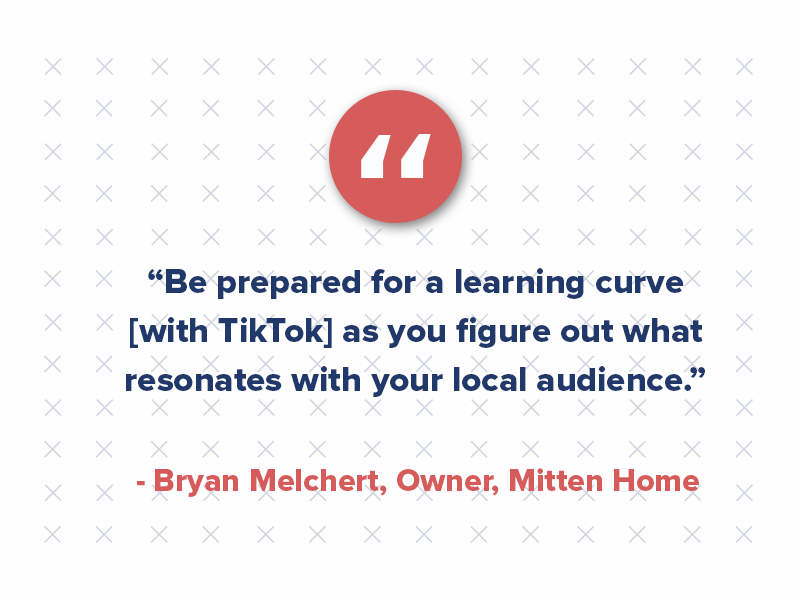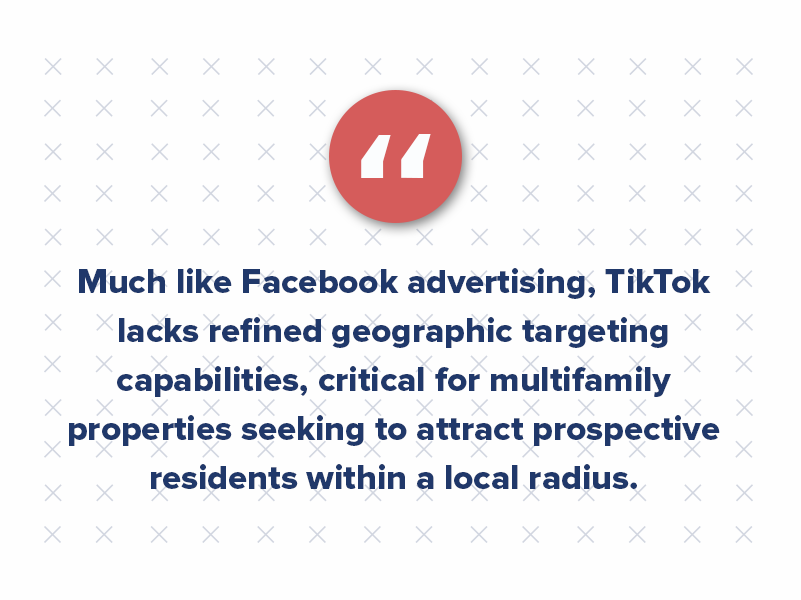Why Our Agency Doesn’t Manage TikTok for Apartments
With its skyrocketing user base and trendsetting influence, TikTok has become a platform that marketers cannot ignore.
As of 2024, TikTok boasts over 1 billion active users, many of whom are from younger demographics, increasingly driving consumer trends. In fact, a third of U.S. adults say they use TikTok, including 39% of adults aged 30-49, and 24% of adults aged 50-64.
But for multifamily marketers, the question remains: Is TikTok worth the time and resources? Can it really deliver tangible results, such as leases, or is it just an engaging addition to the marketing mix without a direct return?

The Rise of TikTok (and What This Means for Multifamily)
TikTok’s rapid growth is undeniable. The platform’s focus on short-form, engaging video content has set it apart from other social platforms. It’s a platform built for quick, organic reach where content has the chance to go viral and capture massive amounts of attention overnight. For multifamily marketers, the opportunity to creatively showcase properties, amenities, and community culture is enticing.

According to recent data, TikTok users average 52 minutes per day on the app, more than many other platforms, suggesting strong engagement levels that could translate to brand recognition and retention.
Many apartment communities have hopped on board, creating property tours, resident testimonials, and local event features to attract prospective renters and engage current residents.
Authenticity on TikTok vs. Agency Management
While TikTok offers unique opportunities for multifamily marketers, the nature of its content poses challenges for agencies aiming to manage this platform on behalf of properties.
Authenticity is essential on TikTok, as its algorithm favors content that feels organic, spontaneous, and genuine — qualities that often come directly from community members or on-site property staff. This focus on realness can make it difficult for agencies to effectively manage a property’s TikTok presence.
Users are drawn to content that feels relatable and unpolished, making videos created by residents or on-site staff more impactful than those produced by external teams.
As Bryan Melchert, owner of Mitten Home Buyer, puts it, “I’ve found success showcasing our renovations and community events. It’s challenging to balance authenticity with polished content, but TikTok’s reach makes it worthwhile. I believe investing time in TikTok pays off more than other platforms — the engagement we get is unmatched.”
This emphasis on authenticity introduces a tension when it comes to agency-created content. Agencies often aim for professional, polished materials, which don’t always resonate with TikTok audiences seeking a more casual, behind-the-scenes experience.
As Melchert points out, “Just be prepared for a learning curve as you figure out what resonates with your local audience.”
For multifamily properties, user-generated content like community events, renovation highlights, and property tours can drive the kind of authentic engagement TikTok rewards.
Another challenge lies in TikTok’s algorithm and ad offerings, which don’t align well with the specific needs of multifamily properties looking to reach local, high-intent audiences.

Here are some key reasons why an agency-managed TikTok strategy may not be as effective as expected:
- Lack of Geographic Targeting: Unlike Facebook or Google, TikTok lacks precise geo-targeting options. Marketers cannot narrow their target audience by zip code, which is a significant drawback for multifamily properties targeting potential renters within specific geographic areas.
- Audience Intent: TikTok users typically engage with entertaining, light-hearted content, meaning they may not be in a “searching for an apartment” mindset. Even if a property goes viral, there’s no guarantee that those interactions will convert to leases.
- The Importance of Authenticity: TikTok’s algorithm favors authentic, user-generated content over polished, brand-generated posts. Agencies managing TikTok often struggle to replicate the genuine tone that resonates on the platform.
Understanding Boosting on TikTok
Boosting posts on TikTok offers some value but is limited by the platform’s lack of precise targeting options.
Although boosting can amplify reach and engagement, the challenge is that boosted posts don’t necessarily reach the audience most likely to convert into renters. Much like Facebook advertising, TikTok lacks refined geographic targeting capabilities, critical for multifamily properties seeking to attract prospective residents within a local radius.

Here’s a closer look at the limitations and insights on boosting:
Reach Without Precision
Boosting posts on TikTok can expand reach significantly, but for multifamily marketers, the platform’s limited geographic targeting presents a challenge. While TikTok offers broad regional targeting, it lacks precision, making it difficult for properties in specific areas to reach local audiences effectively. For instance, a property in Austin, Texas, may find its boosted posts displayed statewide, nationwide, or even internationally — audiences unlikely to translate into viable leads.
Erik Wright, CEO of New Horizon Home Buyers, has seen this firsthand. “Boosted posts definitely do better when targeted locally — we saw about 3x more engagement,” Wright shares, highlighting the need for tighter geographic targeting. However, he notes that focusing on neighborhood amenities and lifestyle content has helped bypass Fair Housing limitations while still reaching relevant audiences. “It’s been worth investing some time in TikTok, especially for reaching younger renters. The organic reach is still pretty good compared to other platforms,” Wright adds. His team has generated qualified leads by creating engaging property tour videos and leaning into organic reach.
Wright’s approach aligns with the strategies used by Carl Fanaro, president of NOLA Buys Houses. “It’s definitely challenging to navigate Fair Housing regulations with limited targeting options, but we’ve found creative ways to work around it,” said Fanaro. Instead of targeting specific demographics, Fanaro’s team creates content that showcases property amenities and local attractions, naturally drawing in their target audience. “While it takes time and effort, I believe TikTok is worth investing in alongside other platforms.”
Despite the challenges, Wright and Fanaro find that TikTok’s organic reach is still competitive, especially for property tour videos and local lifestyle content. “The organic reach is still pretty good compared to other platforms,” Wright said. “We’ve gotten some good leads from fun property tour videos.” His advice? Give TikTok a try — but don’t neglect other channels that may offer more precise targeting and higher conversions.
Cost Efficiency and ROI
TikTok’s ad costs are generally lower than those of Google or Facebook. However, the limited targeting options mean marketers often pay for user engagement outside their desired demographic or geographic area. This cost-per-engagement approach can yield poor ROI for multifamily marketers focused on local leasing goals, whereas other platforms with more defined targeting options may yield better results.
Is Organic TikTok Growth Worth the Time?
TikTok’s organic reach is a strong point for many brands, allowing them to reach vast audiences without spending a dime. For multifamily marketers, organic reach can help boost brand recognition and attract potential renters with engaging, lifestyle-focused content that conveys the property’s culture.
However, organic reach on TikTok is a double-edged sword:
Viral Potential vs. Geographic Relevance
While TikTok offers high organic reach and viral potential, the lack of geographic targeting means that even widely shared posts may have little to no impact on actual leasing.
A video that garners thousands of views or goes viral may sound impressive, but there’s limited leasing impact if those viewers aren’t within a reasonable distance of the property. Engagement doesn’t always equal conversions. This audience could be scattered across the country — even globally — and might not align with the target demographic of potential local renters. This can result in minimal to no impact on lease conversions, highlighting one of the main challenges with TikTok’s reach.
In fact, while boosted posts do increase visibility, research from Influencer Marketing Hub suggests that boosted TikTok content rarely results in more qualified leads. Though enticing, achieving viral success on TikTok can be difficult to replicate and requires a steady stream of authentic, engaging content. Consistency is essential, and the nature of viral content often means investing time and creativity to maintain high-quality posting.
According to Sprout Social, TikTok has one of the highest engagement rates across platforms at 2.65%, far exceeding Instagram’s 0.70%. In certain sectors, like education, food and beverage, and travel, brands experience engagement rates as high as 4.9%. While this engagement might make TikTok appear valuable, the conversion rate doesn’t always match up, especially for multifamily properties needing hyper-local audiences.
It’s also worth noting that TikTok’s engagement rate has been dropping, with last year scoring a 35% decrease in the engagement rate by followers and a 20% decrease in the engagement by views.
Justin Landis, founder of The Justin Landis Group, highlights that success on TikTok largely depends on the audience: “It depends on your audience whether TikTok is worth the investment compared to other platforms. TikTok is worth the effort if your target renters are younger or more tech-savvy. The platform’s viral potential and organic reach can outperform other social platforms, especially for multifamily properties looking to create a fresh, community-focused image. However, a balanced approach with Facebook or Instagram may yield better results for broader or older demographics.”
In multifamily marketing, reaching the right people can be more valuable than reaching a large audience. While TikTok’s potential for engagement is appealing, multifamily properties must weigh whether that engagement leads to tangible results.
The Role of Short-Lived Content
TikTok content is often ephemeral, with most videos having a short lifespan. While TikTok videos can experience bursts of popularity, the attention span is fleeting. This rapid content turnover means that while posts can gain significant engagement quickly, their shelf-life may not justify the investment for long-term leasing goals.
Algorithm-Driven Success
TikTok’s algorithm promotes attention-grabbing videos that appeal to a broad audience, which doesn’t necessarily align with multifamily properties’ specific needs. For example, a video of a property’s pet-friendly amenities may receive plenty of engagement but won’t guarantee leases if viewers aren’t in the area.
What Are the Alternatives to TikTok for Multifamily Marketing?
While Criterion.B is not advising against using TikTok (after all, it’s clearly a booming platform with a growing user base and beneficial for marketing your property to Gen Z), we just advise against using or hiring an agency to help with it.
With TikTok’s massive reach, there’s no denying the platform’s value, but the unique and time-intensive nature of content creation there means that an onsite team can often create more genuine and effective posts.
However, if finding time for this is a challenge, there are alternative platforms and strategies to consider that may yield a more targeted ROI. Here are some options to help balance your digital presence and focus resources wisely (these are also resources a digital marketing agency can easily help you with).
- Local SEO and Google My Business: Optimizing for local search can help properties reach renters actively searching for nearby apartments. Local SEO also offers precise targeting that’s not achievable with TikTok ads.
- YouTube Video Tours: YouTube offers better search functionality and longer video lifespan than TikTok as well as more precise targeting based on location, age, and intent.
- Content Marketing: Creating blog content, virtual tours, and high-quality social media posts on Facebook and Instagram can drive more long-term engagement and SEO value for multifamily properties.
TikTok’s Role in Multifamily Marketing
While TikTok’s explosive growth and impressive engagement rates make it an exciting platform, the drawbacks for multifamily marketers are significant. Without precise targeting capabilities and a way to ensure engagement from geographically relevant audiences, TikTok can be a high-risk, low-reward platform for multifamily properties focused on driving leases.
The potential for increased brand awareness is undeniable, but multifamily marketers should weigh the platform’s limitations and consider if TikTok’s reach aligns with their objectives. Given the lack of geographic targeting and limited conversion potential, Criterion.B advises a cautious approach to TikTok marketing and instead suggests focusing on more reliable, targeted platforms that allow for a greater focus on ROI.
While TikTok may be a fun addition to the marketing mix, the key lies in balancing the need for engaging content with the right targeting approach to maximize your property’s leasing efforts.




